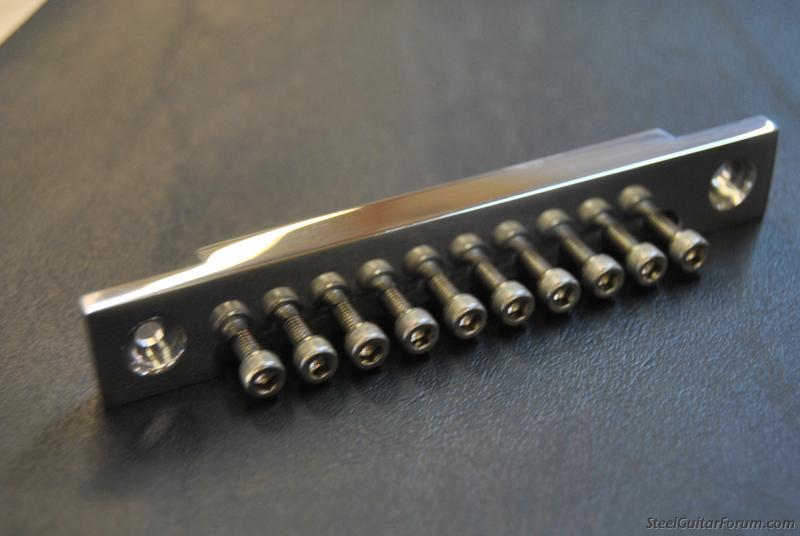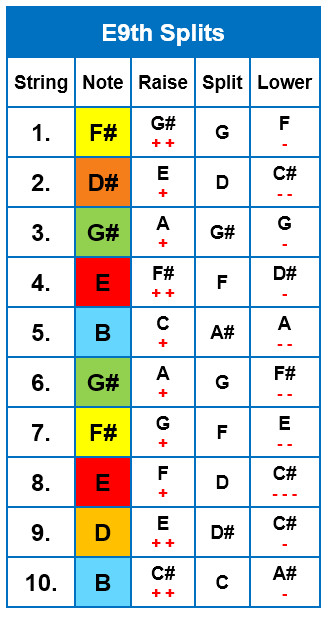Page 1 of 2
Split Tuning
Posted: 24 Mar 2019 10:01 am
by Tommy Shown
Would someone give me some insight about split tun
ing on E 9, and what it is supposed to do?
And as always many thanks
Tommy Shown.
Posted: 24 Mar 2019 11:45 am
by Richard Sinkler
It allows you to raise and lower a string at the same time to get a note that isn't there naturally.
Example: Lower string 6 from G# to F#. Engage pedal B at the same time. The lower to F# on string 6 raises to G when you press the B pedal. This only works EASILY on an all-pull guitar. You need a split tuner to accomplish these changes accurately (barring any super luck without them). The reason being, when you tunes all these notes, the F# on string 6 will be flat. The tuning procedure is:
Using the "extra rod" method.
1. Tune string 6 open to G#.
2. Press the B pedal and tune it to A.
3. While still pressing the B pedal, activate the knee lever lowering string 6. You should now use the lowering nylon tuner to tune a G note.
4. Activate the lever that lowers string 6 only. You will probably notice that the F# note is flat. The extra rod is a raise rod. Use the nylon tuner on that rod to raise the pitch of the F# note so that it is in tune.
Posted: 24 Mar 2019 12:11 pm
by Jack Stoner
Along with the 6th string split mentioned, I have a split on the 5th string. My lower will lower the B string to Bb. The A pedal raises the B string to C# and with the split it lowers the 5th string to C.
An example of the 5th string B split, is with Pedals A and B mashed and the 5th string lower, pick strings 4,5,6 and that gives you a minor - open that would give you an A minor.
Posted: 24 Mar 2019 1:46 pm
by Ian Rae
I don't understand extra rods. All my guitars have split screws in the changer.
I tune the in-between note with the lower nut and the bottom note with the screw.
Posted: 24 Mar 2019 2:12 pm
by Jack Stoner
Some such as the Franklin do not have the split screws. My Franklin has screws for the 5th and 6th strings that were put in at my request by Mr Franklin.
Posted: 25 Mar 2019 12:31 am
by Ian Rae
I have noticed that some guitars have maybe one or two screws, but while you're building, why not drill and tap the lot? You never know.
E9th Splits
Posted: 25 Mar 2019 3:50 am
by Charles Kurck
Posted: 25 Mar 2019 5:32 am
by Richard Sinkler
Ian Rae wrote:I have noticed that some guitars have maybe one or two screws, but while you're building, why not drill and tap the lot? You never know.
I think because most of the time, you only hear of players splitting the 5th and 6th strings. But I agree, why not do all the strings.
I have never owned a guitar with the split screws. My Carter and Mullen have the extra rods, and they work really good. But, I have not tried the screws.
Posted: 25 Mar 2019 7:08 am
by Pete Burak
Sierra used to make an add-on thingee that instantly added a split-screw for a every string (I will add a pic tonight).
I saw some other after-market add-on split-screw units at the Dallas show, one I recall is made by Mullen.
Just an FYI if you have no split-screws and want split-screws.
Here is the Mullen one:

Posted: 25 Mar 2019 1:36 pm
by Ian Rae
Georg, what you say is very illuminating. I shall learn about extra rods as they would solve the problem on the uni where a string such as the middle G# has to perform two roles with two "max lowers".
Posted: 3 Jun 2019 2:06 am
by Ken Byng
My Show Pro uses rods for splits, and it works perfectly.
Posted: 3 Jun 2019 2:16 am
by Ian Rae
Split screws have another disadvantage. The only practical place to put them is closer to the axle than the nearest raise, which makes the adjustment very sensitive. I have to readjust them more often than any of the pulls.
Posted: 3 Jun 2019 2:25 am
by Dustin Rigsby
FWIW, Somewhere on the forum, Tommy White posted that he prefers the extra rod method for tuning stability reasons.
Posted: 3 Jun 2019 2:37 am
by Ian Rae
So there you are - who would argue?

Posted: 3 Jun 2019 5:09 am
by Ron Hogan
Mickey Adams has a good video explaining splits.
CLICK
Posted: 3 Jun 2019 3:13 pm
by Mike Perlowin
I played without them for 25 years, but once I got them, it was like a whole new world of possibilities opened up.
I have 3, on my 4th, 5th, and 8th strings.
Posted: 16 Jul 2019 11:18 am
by Devon Breshears
I'm a newbie, I have a GFI UltraD10 that does not have a split screw mechanism. So, the extra rod would connect to which pedal/lever on the 2nd string for instance? The factory copedant list the RKR change as D/C#, is that where the extra rod should be placed?
Posted: 16 Jul 2019 12:14 pm
by Ian Worley
I think you're talking about a half-stop Devon, which is different than a split.
A half-stop is "feel" stop point at an intermediate note on a single knee lever, the D note in the case you mentioned.
A "split" refers to an intermediate note that is achieved by applying a separate raise and a lower simultaneously on the same string with two different knees or pedals. In most case the resulting intermediate note will end up a little flat. The split tuning methods discussed above correct/compensate for that.
Posted: 16 Jul 2019 12:37 pm
by Richard Sinkler
Devon Breshears wrote:I'm a newbie, I have a GFI UltraD10 that does not have a split screw mechanism. So, the extra rod would connect to which pedal/lever on the 2nd string for instance? The factory copedant list the RKR change as D/C#, is that where the extra rod should be placed?
Does your RKR also lower string 9 from D to C#? That nylon nut on string 9 is where you tune the the D note on the 2nd string. You adjust the nut on the 9th string to start pulling when the 2nd string is at the D note. Adding the resistance from the 9th string pull gives the "feel stop" at D.
Posted: 16 Jul 2019 12:49 pm
by Devon Breshears
Richard Sinkler wrote: Does your RKR also lower string 9 from D to C#? That nylon nut on string 9 is where you tune the the D note on the 2nd string. You adjust the nut on the 9th string to start pulling when the 2nd string is at the D note. Adding the resistance from the 9th string pull gives the "feel stop" at D.
YES! That makes so much sense the way you and Ian explained it. Thanks so much for help a new guy out!
Posted: 9 Feb 2020 4:04 pm
by Gabriel Edell
Devon Breshears wrote:I'm a newbie, I have a GFI UltraD10 that does not have a split screw mechanism. So, the extra rod would connect to which pedal/lever on the 2nd string for instance? The factory copedant list the RKR change as D/C#, is that where the extra rod should be placed?
At the advice of the very helpful people here I added a split rod on the 6th string (G#) of my GFI Ultra S-10 a few months back. I ordered the part from Al Brisco and it wasn't too expensive. It took about 10 minutes to install and another 5 minutes to get it properly adjusted. I am definitely going to install some more.
E9 splits
Posted: 13 May 2020 12:02 am
by Kelcey ONeil
Any one ever put splits on a push pull?
Re: E9 splits
Posted: 13 May 2020 12:36 am
by Ken Byng
Kelcey ONeil wrote:Any one ever put splits on a push pull?
Bobbe Seymour reckoned that it was achievable although he never clarified how. At least on this forum.
Posted: 17 May 2020 6:01 pm
by Kelcey ONeil
TTT, I’m interested in feedback on the push pull splits

